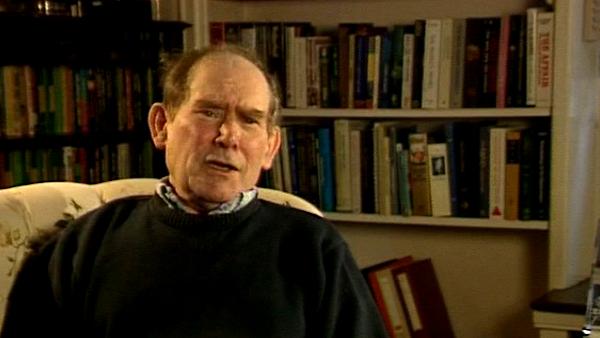NEXT STORY

Automata akin to living cells
RELATED STORIES

NEXT STORY

Automata akin to living cells
RELATED STORIES


|
Views | Duration | |
|---|---|---|---|
| 41. Scientific work undertaken during medical school | 341 | 05:01 | |
| 42. Experiments: really finding things out | 506 | 02:28 | |
| 43. Cambridge or Oxford? | 570 | 02:36 | |
| 44. Hunting for future-proof sciences | 450 | 04:54 | |
| 45. John von Neumann and the history of DNA and self-replication | 2 | 1749 | 07:11 |
| 46. Schrödinger wrong, von Neumann right. | 1490 | 02:05 | |
| 47. Schrödinger's belief in calculating an organism from... | 1026 | 05:00 | |
| 48. Automata akin to living cells | 945 | 03:21 | |
| 49. Biology doesn't allow for relaxing baths | 698 | 01:37 | |
| 50. Work on phage with Hinshelwood in Oxford | 443 | 05:32 |


One of the central things in the Schrödinger's little book What Is Life is what he has to say about the chromosomes containing the program or the code, and he says here… on page 20, he says: 'In calling the structure of the chromosome fibres a code script, we mean that the all penetrating mind once conceived by Laplace, to which every cause or connection lay immediately open, could tell from their structure whether the egg would develop under suitable conditions, into a black cock, or into a speckled hen, into a fly, or a maize plant, a rhododendron, a beetle, a mouse or a woman'. Now, apart from the list of organisms he has given, which falls short of a serious classification of the living world, what he is saying here is that if you could look at the chromosomes, you could compute the… you could calculate the organism, but he's saying something more. He's saying that you could actually implement the organism because he goes on to add: 'But the term code script is of course too narrow. The chromosome structures are at the same time instrumental in bringing about the development they foreshadow. They are law code and executive power, or to use another simile they are architect's plan and builder's craft in one.' What he is saying here is that the chromosomes not only contain a description of the future organism but the means to implement that description or program as we might call it. That's wrong, because they don't contain the means to implement it, they only contain a description of the means to implement it and that distinction was made absolutely crystal clear by this remarkable paper of von Neumann, in which he develops and in fact provides a proof of what a self-reproducing automaton – or machine – would have to… would have to contain in order to satisfy the requirements of self-reproduction. He develops this concept of course from the earlier concept of Turing, who had developed ideas of automata that operated on tapes and which of course gave a mechanical example of how you might implement some computation. And if you like, this is the beginning of the theory of computation and what von Neumann has to say about this is made very clear in this essay. And he says that you've got to have several components, and I'll just summarise them. He said you first start with an automaton A, 'which, when furnished this description of any other automaton in terms of the appropriate functions, will construct that entity'. It's like a Turing machine, you see. So automaton A has to be given a tape and then it'll make another automaton A, all right. Now what you have, you've got to have… add to this automaton B. 'Automaton B can make a copy of any instruction I that is furnished to it', so if you give it a program, it'll copy the program. And then you have… you combine A and B with each other and you give a control mechanism C, that you have to add as well, which does the following. It says, 'Let A be furnished with the instruction I'. So you give... you give the tape to A, A copies it under the control of C, okay, by every description, so it makes another copy of A, then you… and of course B is part of A. Then you… C then tells B, 'copy this tape I', gives B the copying part of it, this copies it and then C will then take the tape I, and put it into the new machine, okay, and turns it loose as he says here, 'as an independent entity'.
South African Sydney Brenner (1927-2019) was awarded the Nobel Prize in Physiology or Medicine in 2002. His joint discovery of messenger RNA, and, in more recent years, his development of gene cloning, sequencing and manipulation techniques along with his work for the Human Genome Project have led to his standing as a pioneer in the field of genetics and molecular biology.
Title: Schrödinger's belief in calculating an organism from chromosomes
Listeners: Lewis Wolpert
Lewis Wolpert is Professor of Biology as Applied to Medicine in the Department of Anatomy and Developmental Biology of University College, London. His research interests are in the mechanisms involved in the development of the embryo. He was originally trained as a civil engineer in South Africa but changed to research in cell biology at King's College, London in 1955. He was made a Fellow of the Royal Society in 1980 and awarded the CBE in 1990. He was made a Fellow of the Royal Society of Literature in 1999. He has presented science on both radio and TV and for five years was Chairman of the Committee for the Public Understanding of Science.
Tags: What Is Life, Erwin Schrödinger, Pierre-Simon Laplace, John von Neumann, Alan Turing
Duration: 5 minutes, 1 second
Date story recorded: April-May 1994
Date story went live: 24 January 2008